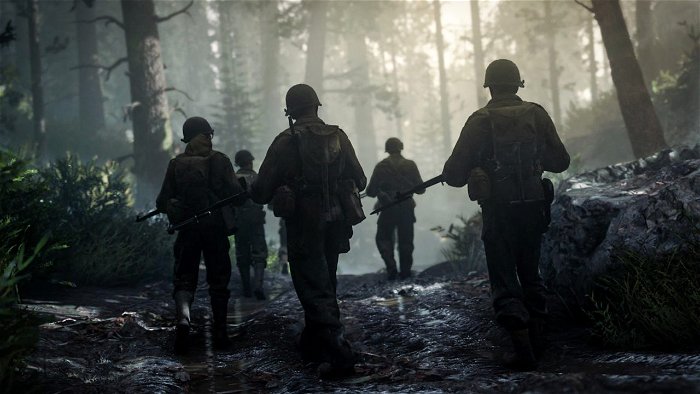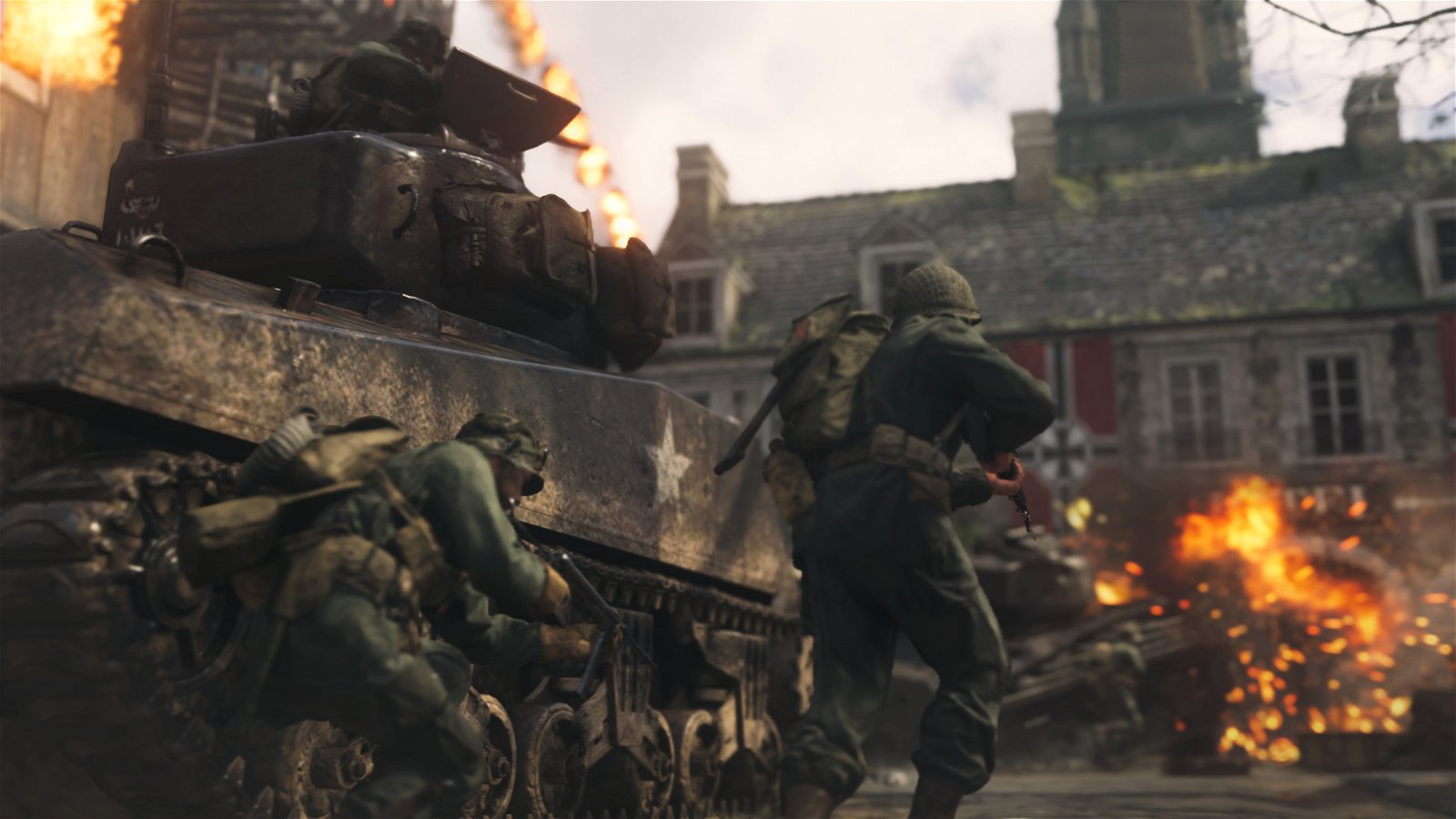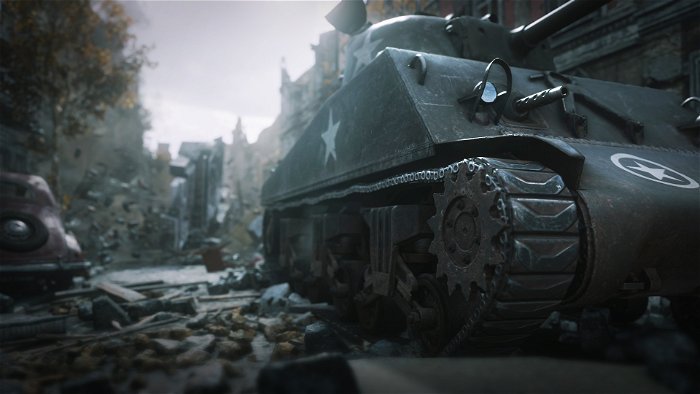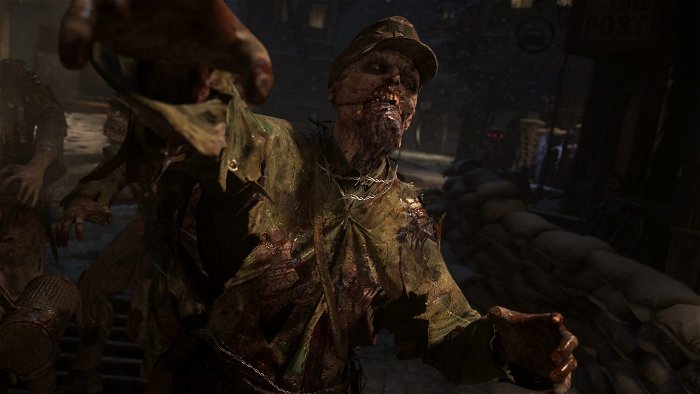It’s been 11 years since the Call of Duty franchise was set in the Second World War.
The franchise began with this conflict but over the last decade has tackled settings ranging from modern conflict to near-future warfare. However, with Wolfenstein II: The New Colossus dropping recently to the praise of critics and fans, it seems that players are ready to once again strap on their boots and kick some Nazi ass. CGMagazine was lucky enough to snag an interview with Michael Condrey, the Chief Operating and Development Officer and co-founder of Sledgehammer games, to ask him why the company decided to return to European Theatre after so many years, what it means to make a game based off a real conflict, and the research that went into ensuring the game paid proper tribute to the men and women who fought and died during those years.
CGMagazine: Why the decision to go back to the Second World War?
Michael Condrey: It’s interesting we had these really intense three year dev cycles and through the course of it you really try to respond to what the fans are saying to the studio and the franchise about what they want and what they’re interested in trying to be predictive about trends. It’s a really interesting exercise creatively to try and figure out what is going to excite fans three years down the road. Coming out of Advanced Warfare, that game was really positioned at a time when near-future technology had become the pop-culture zeitgeist. There were films like Edge of Tomorrow and Elysium and Oblivion. We didn’t know that when we first started we just wanted to tell this story and bring new exciting ways to play Call of Duty and that’s what was represented.
At the end of that game the creative exercise followed that process, we started thinking about stories that were meaningful, stories that hadn’t been told in a while, new ways to have player play in the franchise that they love and we saw then this opportunity to use the greatest conflict in human history as a backdrop to go back to the Second World War where great stories hadn’t been told in at least a decade, and fast forward to today and I think we’re seeing again. We recently had Dunkirk as an example. That’s exciting to us because for many of us, myself included, it’s been 10–20 years since we’ve had a great piece of the Second World War entertainment and ten years for Call of Duty. In response to fans wanting to go back to more grounded, authentic boots-on-the-ground experience and for Sledgehammer games to get a chance to reboot the franchise and take it back to its beloved roots. We’re excited because right now it feels like absolutely the right game for Call of Duty at the right time for fans.
CGMagazine: Following that, what are the major differences from a development standpoint between a real historical setting and a fictional one where you have creative freedom to do whatever you like?
Michael Condrey: The creative opportunities for this were very, very different. Advanced Warfare, for the longest time we were really trying to paint this canvas of a believable near-future conflict and world, and I remember we engaged with some futurists. These are academics who spend their careers trying to predict where the future is going. We brought in a series of futurists, very famous ones for a speaker series for the studio to get this studio creatively immersed in near-future challenges. We had two speakers, one right after the other, in the course of a week. The first one described the singularity, the moment when man and machine come together to become one. The next speaker described how modern conflict at scale was going to essentially take us back 50–60 years because all the tech we rely on today was going to get destroyed in the course of these large-scale global conflicts. We were going to go back in time 50 years to a more analog society because satellites with EMPS were going to happen and set us back decades. Even within a very academically informed perspective at the time, these two experts couldn’t agree on what 40 years down the road meant. So we had to paint that, we had to paint it to the studio, to each other, and to the fans. A lot of creative time was spent trying to have people understand the world, the protagonists, the antagonists, the geopolitics, and the technologies. We researched a ton of what was coming but even then it was hard to get people to fully believe that these things could happen.
[Call of Duty: WWII] in contrast was just the opposite, obviously, this is a clear moment in human history of true good vs. evil, it’s well documented, the iconic battles, the technology, the geopolitics, the state of racial tension. That all existed, so this creative opportunity was very different. We had to really capture the spirit and recreate an authentic depiction of this very well important time in human history. We commanded ourselves to very different creative challenges; in this we made sure we honoured the sacrifice, the bravery, and the camaraderie of the greatest generation. That became about researching these battles in a profound way that we had never really done before, at least I hadn’t in my 20-year career. We went to every battle site that’s represented in the game, we took tens of thousands of photos, we went out with veterans, we went to incredible Second World War history museums in Luxembourg and Berlin and New Orleans. This was about really sinking into the stories, the artifacts, the factual recreation of what was happening in the Second World War and finding a way to deliver that in a piece of entertainment that honoured the cause.
CGMagazine: How do you draw the line between an accurate simulation of battle and making a fun video game?
Michael Condrey: That’s something that we were wrestling with throughout the course of development. It is a piece of entertainment, and yet because the subject matter is so profound and personal and represents such a loss of life. Along with the conflict, the holocaust, the genocide, famine and things that happened because of the war. We had to find a way to balance being respectful and honouring what happened without glorifying it and still recognizing that we were delivering a piece of entertainment. Each mode of the game had slightly different guardrails when it came to that. As you can imagine the campaign was really centred on delivering this powerful emotional journey of the squad on a human level, but Nazi Zombies as you can imagine was able to break free from all of that and was very entertaining and twisted. And multiplayer was in the middle, social and competitive but we wanted to make you feel like you were in this gritty Second World War conflict with real weapons and real iconic locations. The one thing through all this research, we found story after story after story of amazing examples of bravery and heroics and massive scale war, as you know. Like D-Day where 5,000 men died on the beach just trying to land. There are these big moments that we were able to depict and then we were able to have those quiet intense moments and were able to touch on the challenges. One of our allied soldiers is a Jewish American and you can imagine the challenges he faced. We had plenty of stories to draw from because the war itself was truly a world at war.
CGMagazine: Are the characters in the game fictional or based on real people? Or are they an amalgamation of the two?
Michael Condrey: We describe this as being based on true events, and it is. We follow the Allied invasion of Europe through the beaches of Normandy into France; we follow a squad within the 1st Infantry. In the war itself, in real life, that’s a group of 15,000 men. Our story follows a small squad and the journey they’re on is an original story for us. It’s based off real stories that we uncovered through all this research, some new ones we didn’t know a decade ago and the battles of course the backdrop, Normandy, Operation Cobra, one of the largest bombing battles in the history of man, the fight for Northern Germany—all of these things really took place. Amidst true events we crafted this original story.
CGMagazine: How do you translate the mechanics of real weapons used in the war into a video game?
Michael Condrey: One of the things that we were really excited about, and it goes back to your original question about the creative differences between entries, these weapons exist today and they’ve been depicted in other forms of entertainment for years and years so we wanted to capture the authenticity of this gear, the uniforms, the weapons, the locations, so it really came down to research, going to these sites and in the case of the weapons and the gear, getting access. We engaged with one of the premiere military historians, we met him through the World War 2 history museum in New Orleans. He transcribed all of the interviews from the 101st for Stephen Ambrose who wrote Band of Brothers, and he got us access to everything that we needed to see. We took these weapons to firing ranges, we felt them, we fired them, we reloaded them, we captured their sound, and we captured their muzzle flashes. We went to armouries and drove half-tracks; he dragged us all over Europe to all the battle sites. That was really remarkable for us to bring all those assets to life in the game, and do it authentically.
CGMagazine: I got to review the game on the Xbox One X and it looks just ridiculous, I was pretty impressed by that. Is it fun for you guys having access to that kind of power for console players? Did you get to go a bit farther with things that you couldn’t do before?
Michael Condrey: Thinking about what we were able to do ten years ago when the franchise was in the Second World War and what we can do today and it’s remarkable. The power of the latest consoles, like the Pro and Xbox One X, and you think about 4K and HDR and the graphic fidelity of what we can pull off. We actually captured using the exact techniques and technology that James Cameron uses for his Avatar 2 facial performances. We are there using exactly what the best of Hollywood is doing today to bring that fidelity to life that these consoles can allow. When you’re telling this very personal story, when you’re really trying to capture the nuances of the facial expression of the terror of war to a 19-year-old kid in the Battle of the Bulge, you need to be able to get those very nuanced features in the eyes and the mouth and the reaction. We certainly couldn’t have done that ten years ago; these consoles are amazing.
CGMagazine: How did you guys approach the lootbox system? It’s a rather contentious issue in the gaming community right now.
Michael Condrey: It’s really interesting for us because we are on the creative side, while Activision handles the business and financial side. But for us, six years ago on Advanced Warfare we started that game and saw a need to really have players feel like they were invested in crafting their character, to be rewarded and customized and really make it feel like an extension of you. We’ve always said that Call of Duty multiplayer is about putting you in the conflict and whether it’s you or me, we’re all going to take a slightly different look on our uniform, our weapon, and we really wanted to bring that to life. In Advanced Warfare, that’s the first time you had a character that you could customize. Loot was really just a creative evolution of trying to give more rewards and customization options to players to really feel customized. Coming out of Advanced Warfare, the things we heard loud and clear were that players wanted it to feel like it was balanced, so all of our loot is cosmetic only. There’s no stat variance to our loot in a way that would make people like somebody else has an advantage in combat, which is super important for the community. They don’t to feel like “I lost to a guy because he had a better loot variant than I did” so we capped off weapons completely and I think that was a big step for us…Between taking off any stat, so there’s no perceived advantage for loot, and making it all cosmetic while also ensuring that players could earn their way to all the things they wanted, it feels in our opinion a much better fan experience.

CGMagazine: Was it important for you to remind people that the Nazis were the bad guys, especially given the last several months with the rise of the alt-right and the events in Charlottesville? It seems that a lot of people in this generation have kind of forgotten what happened. Was that important for you guys to present that?
Michael Condrey: One of the early research trips we did to New Orleans with our Military Historian…he took me out to this square and there was this statue with its back to the square, kind of a bit overgrown, a little out of sight, nobody was around. It was a monument to the Spanish American War, and he said, “What can you tell me about the Spanish American War?” I couldn’t tell him anything. He then said, “Look, Second World War to the fans of games today is as far from them as this war is from you.” These are stories that are lost. This is a cause and a time that is largely outside of the reference of pop culture. In fact, when he was transcribing Band of Brothers, he met Captain Winters and the 101st. Those were all heroic veterans who he could interview. They’ve all passed, so when we started three years ago it was about telling this story because it’s an important story in human history to ensure we don’t allow it to happen again. It became even more profound to us because we were also telling the story on behalf of these brave men and women who are no longer here to tell it themselves. That sentiment made this a very powerful game for all of us here at Sledgehammer. A really profound story to tell and certainly the most personal story we’ve ever told in games.
CGMagazine: That’s all I have Michael, thanks so much.
Michael Condrey: Great talking with you and I hope you enjoy the game.








